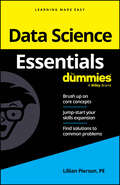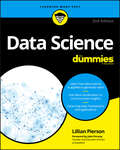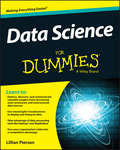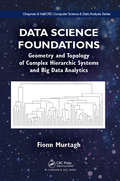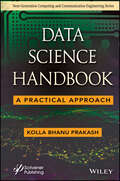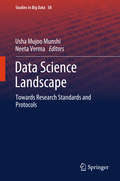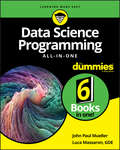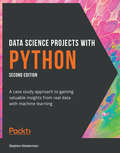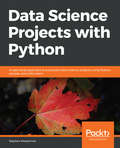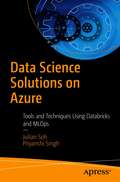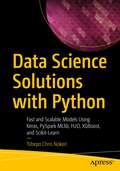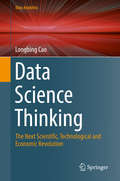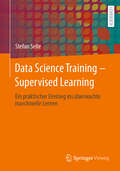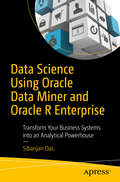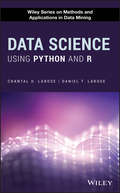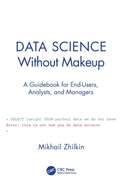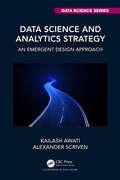- Table View
- List View
Data Science Crash Course for Beginners: Learn data science fast with this practical guide
by AI Sciences OUThis course lays the groundwork for further study into data science with Python for those students with little to no experienceKey FeaturesCrash course in Python programming to build or refresh any gaps in prerequisite knowledgeReal-world projects for hands-on practice in various data science tasksAccess to all codes and datasets free to view onlineBook DescriptionData science is here to stay. The tremendous growth in the volume, velocity, and variety of data has a substantial impact on every aspect of a business. While data continues to grow exponentially, accuracy remains a problem. This is where data scientists play a decisive role.A data scientist analyzes data, discovers new insights, paints a picture, and creates a vision. And a competent data scientist will provide a business with the competitive edge it needs and to address pressing business problems.Data Science Crash Course for Beginners with Python presents you with a hands-on approach to learn data science fast. This book presents you with the tools and packages you need to kick-start data science projects to resolve problems of a practical nature. Special emphasis is laid on the main stages of a data science pipeline—data acquisition, data preparation, exploratory data analysis, data modeling and evaluation, and interpretation of the results.The author simplifies your learning by providing detailed, guided instructions through everything. The step-by-step description of the installation of the software you need to implement the various data science techniques in this book is guaranteed to make your learning easier. So, right from the beginning, you can experiment with the practical aspects of data science. By the end of this course, you will have a solid grasp on the essential concepts of data science and its most fundamental implementations, laying the groundwork for your next steps no matter your chosen direction.The code bundle for this course is available at https://www.aispublishing.net/book-data-science-01What you will learnConsider Natural Language Processing and decision making in data scienceInstall Python and libraries for data scienceReview Python for data scienceStudy data acquisitionPractice data preparation (preprocessing)Perform exploratory data analysisExplore data modeling and evaluation using machine learningInterpret data and report your findingsSuccessfully complete several data science projectsWho this book is forThis book is specifically designed for beginners in data science looking to build foundational tools and skills quickly, utilizing the Python programming language. No prior experience is required.
Data Science Essentials For Dummies
by Lillian PiersonFeel confident navigating the fundamentals of data science Data Science Essentials For Dummies is a quick reference on the core concepts of the exploding and in-demand data science field, which involves data collection and working on dataset cleaning, processing, and visualization. This direct and accessible resource helps you brush up on key topics and is right to the point—eliminating review material, wordy explanations, and fluff—so you get what you need, fast. Strengthen your understanding of data science basics Review what you've already learned or pick up key skills Effectively work with data and provide accessible materials to others Jog your memory on the essentials as you work and get clear answers to your questions Perfect for supplementing classroom learning, reviewing for a certification, or staying knowledgeable on the job, Data Science Essentials For Dummies is a reliable reference that's great to keep on hand as an everyday desk reference.
Data Science Essentials in Python: Collect - Organize - Explore - Predict - Value
by Dmitry ZinovievGo from messy, unstructured artifacts stored in SQL and NoSQL databases to a neat, well-organized dataset with this quick reference for the busy data scientist. Understand text mining, machine learning, and network analysis; process numeric data with the NumPy and Pandas modules; describe and analyze data using statistical and network-theoretical methods; and see actual examples of data analysis at work. This one-stop solution covers the essential data science you need in Python.Data science is one of the fastest-growing disciplines in terms of academic research, student enrollment, and employment. Python, with its flexibility and scalability, is quickly overtaking the R language for data-scientific projects. Keep Python data-science concepts at your fingertips with this modular, quick reference to the tools used to acquire, clean, analyze, and store data.This one-stop solution covers essential Python, databases, network analysis, natural language processing, elements of machine learning, and visualization. Access structured and unstructured text and numeric data from local files, databases, and the Internet. Arrange, rearrange, and clean the data. Work with relational and non-relational databases, data visualization, and simple predictive analysis (regressions, clustering, and decision trees). See how typical data analysis problems are handled. And try your hand at your own solutions to a variety of medium-scale projects that are fun to work on and look good on your resume.Keep this handy quick guide at your side whether you're a student, an entry-level data science professional converting from R to Python, or a seasoned Python developer who doesn't want to memorize every function and option.What You Need:You need a decent distribution of Python 3.3 or above that includes at least NLTK, Pandas, NumPy, Matplotlib, Networkx, SciKit-Learn, and BeautifulSoup. A great distribution that meets the requirements is Anaconda, available for free from www.continuum.io. If you plan to set up your own database servers, you also need MySQL (www.mysql.com) and MongoDB (www.mongodb.com). Both packages are free and run on Windows, Linux, and Mac OS.
Data Science For Dummies
by Lillian Pierson Jake PorwayYour ticket to breaking into the field of data science! Jobs in data science are projected to outpace the number of people with data science skills—making those with the knowledge to fill a data science position a hot commodity in the coming years. Data Science For Dummies is the perfect starting point for IT professionals and students interested in making sense of an organization's massive data sets and applying their findings to real-world business scenarios. From uncovering rich data sources to managing large amounts of data within hardware and software limitations, ensuring consistency in reporting, merging various data sources, and beyond, you'll develop the know-how you need to effectively interpret data and tell a story that can be understood by anyone in your organization. Provides a background in data science fundamentals and preparing your data for analysis Details different data visualization techniques that can be used to showcase and summarize your data Explains both supervised and unsupervised machine learning, including regression, model validation, and clustering techniques Includes coverage of big data processing tools like MapReduce, Hadoop, Dremel, Storm, and Spark It's a big, big data world out there—let Data Science For Dummies help you harness its power and gain a competitive edge for your organization.
Data Science For Dummies
by Lillian PiersonDiscover how data science can help you gain in-depth insight into your business - the easy way! Jobs in data science abound, but few people have the data science skills needed to fill these increasingly important roles in organizations. Data Science For Dummies is the perfect starting point for IT professionals and students interested in making sense of their organization's massive data sets and applying their findings to real-world business scenarios. From uncovering rich data sources to managing large amounts of data within hardware and software limitations, ensuring consistency in reporting, merging various data sources, and beyond, you'll develop the know-how you need to effectively interpret data and tell a story that can be understood by anyone in your organization. Provides a background in data science fundamentals before moving on to working with relational databases and unstructured data and preparing your data for analysis Details different data visualization techniques that can be used to showcase and summarize your data Explains both supervised and unsupervised machine learning, including regression, model validation, and clustering techniques Includes coverage of big data processing tools like MapReduce, Hadoop, Dremel, Storm, and Spark It's a big, big data world out there - let Data Science For Dummies help you harness its power and gain a competitive edge for your organization.
Data Science For Dummies
by Lillian PiersonMake smart business decisions with your data by design! Take a deep dive to understand how developing your data science dogma can drive your business—ya dig? Every phone, tablet, computer, watch, and camera generates data—we’re overwhelmed with the stuff. That’s why it’s become increasingly important that you know how to derive useful insights from the data you have to understand which piece of data in the sea of data is important and which isn’t (trust us: not as scary as it sounds!), and to rely on said data to make critical business decisions. Enter the world of data science: the practice of using scientific methods, processes, and algorithms to gain knowledge and insights from any type of data. Data Science For Dummies provides a comprehensive introduction in that friendly and approachable way you’ve come to know from Dummies. Your new go-to guide breaks down this vast topic into three smaller parts—big data, data science, and data engineering—and then shows you how to combine those areas to produce value and make informed decisions to drive business growth. It’s also filled with real-world examples and applications that you can apply to your situation. Data Science For Dummies demonstrates: How natural language processing works Strategies around data science How to make decisions using probabilities Ways to display your data using a visualization model How to incorporate various programming languages into your strategy Whether you’re a professional or a student, Data Science For Dummies will get you caught up on all the latest data trends. Find out how to ask the pressing questions you need your data to answer by picking up your copy today.
Data Science Foundations: Geometry and Topology of Complex Hierarchic Systems and Big Data Analytics (Chapman & Hall/CRC Computer Science & Data Analysis)
by Fionn Murtagh"Data Science Foundations is most welcome and, indeed, a piece of literature that the field is very much in need of…quite different from most data analytics texts which largely ignore foundational concepts and simply present a cookbook of methods…a very useful text and I would certainly use it in my teaching."- Mark Girolami, Warwick University Data Science encompasses the traditional disciplines of mathematics, statistics, data analysis, machine learning, and pattern recognition. This book is designed to provide a new framework for Data Science, based on a solid foundation in mathematics and computational science. It is written in an accessible style, for readers who are engaged with the subject but not necessarily experts in all aspects. It includes a wide range of case studies from diverse fields, and seeks to inspire and motivate the reader with respect to data, associated information, and derived knowledge.
Data Science Fundamentals with R, Python, and Open Data
by Marco CremoniniData Science Fundamentals with R, Python, and Open Data Introduction to essential concepts and techniques of the fundamentals of R and Python needed to start data science projects Organized with a strong focus on open data, Data Science Fundamentals with R, Python, and Open Data discusses concepts, techniques, tools, and first steps to carry out data science projects, with a focus on Python and RStudio, reflecting a clear industry trend emerging towards the integration of the two. The text examines intricacies and inconsistencies often found in real data, explaining how to recognize them and guiding readers through possible solutions, and enables readers to handle real data confidently and apply transformations to reorganize, indexing, aggregate, and elaborate. This book is full of reader interactivity, with a companion website hosting supplementary material including datasets used in the examples and complete running code (R scripts and Jupyter notebooks) of all examples. Exam-style questions are implemented and multiple choice questions to support the readers’ active learning. Each chapter presents one or more case studies. Written by a highly qualified academic, Data Science Fundamentals with R, Python, and Open Data discuss sample topics such as: Data organization and operations on data frames, covering reading CSV dataset and common errors, and slicing, creating, and deleting columns in R Logical conditions and row selection, covering selection of rows with logical condition and operations on dates, strings, and missing values Pivoting operations and wide form-long form transformations, indexing by groups with multiple variables, and indexing by group and aggregations Conditional statements and iterations, multicolumn functions and operations, data frame joins, and handling data in list/dictionary format Data Science Fundamentals with R, Python, and Open Data is a highly accessible learning resource for students from heterogeneous disciplines where Data Science and quantitative, computational methods are gaining popularity, along with hard sciences not closely related to computer science, and medical fields using stochastic and quantitative models.
Data Science Handbook: A Practical Approach
by Kolla Bhanu PrakashDATA SCIENCE HANDBOOK This desk reference handbook gives a hands-on experience on various algorithms and popular techniques used in real-time in data science to all researchers working in various domains. Data Science is one of the leading research-driven areas in the modern era. It is having a critical role in healthcare, engineering, education, mechatronics, and medical robotics. Building models and working with data is not value-neutral. We choose the problems with which we work, make assumptions in these models, and decide on metrics and algorithms for the problems. The data scientist identifies the problem which can be solved with data and expert tools of modeling and coding. The book starts with introductory concepts in data science like data munging, data preparation, and transforming data. Chapter 2 discusses data visualization, drawing various plots and histograms. Chapter 3 covers mathematics and statistics for data science. Chapter 4 mainly focuses on machine learning algorithms in data science. Chapter 5 comprises of outlier analysis and DBSCAN algorithm. Chapter 6 focuses on clustering. Chapter 7 discusses network analysis. Chapter 8 mainly focuses on regression and naive-bayes classifier. Chapter 9 covers web-based data visualizations with Plotly. Chapter 10 discusses web scraping. The book concludes with a section discussing 19 projects on various subjects in data science. Audience The handbook will be used by graduate students up to research scholars in computer science and electrical engineering as well as industry professionals in a range of industries such as healthcare.
Data Science Landscape: Towards Research Standards And Protocols (Studies in Big Data #38)
by Usha Mujoo Munshi Neeta VermaThe edited volume deals with different contours of data science with special reference to data management for the research innovation landscape. The data is becoming pervasive in all spheres of human, economic and development activity. In this context, it is important to take stock of what is being done in the data management area and begin to prioritize, consider and formulate adoption of a formal data management system including citation protocols for use by research communities in different disciplines and also address various technical research issues. The volume, thus, focuses on some of these issues drawing typical examples from various domains. The idea of this work germinated from the two day workshop on “Big and Open Data – Evolving Data Science Standards and Citation Attribution Practices”, an international workshop, led by the ICSU-CODATA and attended by over 300 domain experts. The Workshop focused on two priority areas (i) Big and Open Data: Prioritizing, Addressing and Establishing Standards and Good Practices and (ii) Big and Open Data: Data Attribution and Citation Practices. This important international event was part of a worldwide initiative led by ICSU, and the CODATA-Data Citation Task Group. In all, there are 21 chapters (with 21st Chapter addressing four different core aspects) written by eminent researchers in the field which deal with key issues of S&T, institutional, financial, sustainability, legal, IPR, data protocols, community norms and others, that need attention related to data management practices and protocols, coordinate area activities, and promote common practices and standards of the research community globally. In addition to the aspects touched above, the national / international perspectives of data and its various contours have also been portrayed through case studies in this volume.
Data Science Programming All-In-One For Dummies
by John Paul Mueller Luca MassaronYour logical, linear guide to the fundamentals of data science programming Data science is exploding—in a good way—with a forecast of 1.7 megabytes of new information created every second for each human being on the planet by 2020 and 11.5 million job openings by 2026. It clearly pays dividends to be in the know. This friendly guide charts a path through the fundamentals of data science and then delves into the actual work: linear regression, logical regression, machine learning, neural networks, recommender engines, and cross-validation of models. Data Science Programming All-In-One For Dummies is a compilation of the key data science, machine learning, and deep learning programming languages: Python and R. It helps you decide which programming languages are best for specific data science needs. It also gives you the guidelines to build your own projects to solve problems in real time. Get grounded: the ideal start for new data professionals What lies ahead: learn about specific areas that data is transforming Be meaningful: find out how to tell your data story See clearly: pick up the art of visualization Whether you’re a beginning student or already mid-career, get your copy now and add even more meaning to your life—and everyone else’s!
Data Science Projects with Python: A case study approach to gaining valuable insights from real data with machine learning, 2nd Edition
by Stephen KlostermanGain hands-on experience of Python programming with industry-standard machine learning techniques using pandas, scikit-learn, and XGBoostKey FeaturesThink critically about data and use it to form and test a hypothesisChoose an appropriate machine learning model and train it on your dataCommunicate data-driven insights with confidence and clarityBook DescriptionIf data is the new oil, then machine learning is the drill. As companies gain access to ever-increasing quantities of raw data, the ability to deliver state-of-the-art predictive models that support business decision-making becomes more and more valuable.In this book, you'll work on an end-to-end project based around a realistic data set and split up into bite-sized practical exercises. This creates a case-study approach that simulates the working conditions you'll experience in real-world data science projects.You'll learn how to use key Python packages, including pandas, Matplotlib, and scikit-learn, and master the process of data exploration and data processing, before moving on to fitting, evaluating, and tuning algorithms such as regularized logistic regression and random forest.Now in its second edition, this book will take you through the end-to-end process of exploring data and delivering machine learning models. Updated for 2021, this edition includes brand new content on XGBoost, SHAP values, algorithmic fairness, and the ethical concerns of deploying a model in the real world.By the end of this data science book, you'll have the skills, understanding, and confidence to build your own machine learning models and gain insights from real data.What you will learnLoad, explore, and process data using the pandas Python packageUse Matplotlib to create compelling data visualizationsImplement predictive machine learning models with scikit-learnUse lasso and ridge regression to reduce model overfittingEvaluate random forest and logistic regression model performanceDeliver business insights by presenting clear, convincing conclusionsWho this book is forData Science Projects with Python – Second Edition is for anyone who wants to get started with data science and machine learning. If you're keen to advance your career by using data analysis and predictive modeling to generate business insights, then this book is the perfect place to begin. To quickly grasp the concepts covered, it is recommended that you have basic experience of programming with Python or another similar language, and a general interest in statistics.
Data Science Projects with Python: A case study approach to successful data science projects using Python, pandas, and scikit-learn
by Stephen KlostermanGain hands-on experience with industry-standard data analysis and machine learning tools in PythonKey FeaturesLearn techniques to use data to identify the exact problem to be solvedVisualize data using different graphsIdentify how to select an appropriate algorithm for data extractionBook DescriptionData Science Projects with Python is designed to give you practical guidance on industry-standard data analysis and machine learning tools in Python, with the help of realistic data. The book will help you understand how you can use pandas and Matplotlib to critically examine a dataset with summary statistics and graphs, and extract the insights you seek to derive. You will continue to build on your knowledge as you learn how to prepare data and feed it to machine learning algorithms, such as regularized logistic regression and random forest, using the scikit-learn package. You’ll discover how to tune the algorithms to provide the best predictions on new and, unseen data. As you delve into later chapters, you’ll be able to understand the working and output of these algorithms and gain insight into not only the predictive capabilities of the models but also their reasons for making these predictions. By the end of this book, you will have the skills you need to confidently use various machine learning algorithms to perform detailed data analysis and extract meaningful insights from unstructured data.What you will learnInstall the required packages to set up a data science coding environmentLoad data into a Jupyter Notebook running PythonUse Matplotlib to create data visualizationsFit a model using scikit-learnUse lasso and ridge regression to reduce overfittingFit and tune a random forest model and compare performance with logistic regressionCreate visuals using the output of the Jupyter NotebookWho this book is forIf you are a data analyst, data scientist, or a business analyst who wants to get started with using Python and machine learning techniques to analyze data and predict outcomes, this book is for you. Basic knowledge of computer programming and data analytics is a must. Familiarity with mathematical concepts such as algebra and basic statistics will be useful.
Data Science Revealed: With Feature Engineering, Data Visualization, Pipeline Development, and Hyperparameter Tuning
by Tshepo Chris NokeriGet insight into data science techniques such as data engineering and visualization, statistical modeling, machine learning, and deep learning. This book teaches you how to select variables, optimize hyper parameters, develop pipelines, and train, test, and validate machine and deep learning models. Each chapter includes a set of examples allowing you to understand the concepts, assumptions, and procedures behind each model.The book covers parametric methods or linear models that combat under- or over-fitting using techniques such as Lasso and Ridge. It includes complex regression analysis with time series smoothing, decomposition, and forecasting. It takes a fresh look at non-parametric models for binary classification (logistic regression analysis) and ensemble methods such as decision trees, support vector machines, and naive Bayes. It covers the most popular non-parametric method for time-event data (the Kaplan-Meier estimator). It also covers ways of solving classification problems using artificial neural networks such as restricted Boltzmann machines, multi-layer perceptrons, and deep belief networks. The book discusses unsupervised learning clustering techniques such as the K-means method, agglomerative and Dbscan approaches, and dimension reduction techniques such as Feature Importance, Principal Component Analysis, and Linear Discriminant Analysis. And it introduces driverless artificial intelligence using H2O.After reading this book, you will be able to develop, test, validate, and optimize statistical machine learning and deep learning models, and engineer, visualize, and interpret sets of data.What You Will LearnDesign, develop, train, and validate machine learning and deep learning modelsFind optimal hyper parameters for superior model performanceImprove model performance using techniques such as dimension reduction and regularizationExtract meaningful insights for decision making using data visualizationWho This Book Is ForBeginning and intermediate level data scientists and machine learning engineers
Data Science Solutions on Azure: The Rise of Generative AI and Applied AI
by Julian Soh Priyanshi SinghThis revamped and updated book focuses on the latest in AI technology—Generative AI. It builds on the first edition by moving away from traditional data science into the area of applied AI using the latest breakthroughs in Generative AI. Based on real-world projects, this edition takes a deep look into new concepts and approaches such as Prompt Engineering, testing and grounding of Large Language Models, fine tuning, and implementing new solution architectures such as Retrieval Augmented Generation (RAG). You will learn about new embedded AI technologies in Search, such as Semantic and Vector Search. Written with a view on how to implement Generative AI in software, this book contains examples and sample code. In addition to traditional Data Science experimentation in Azure Machine Learning (AML) that was covered in the first edition, the authors cover new tools such as Azure AI Studio, specifically for testing and experimentation with Generative AI models. What's New in this Book Provides new concepts, tools, and technologies such as Large and Small Language Models, Semantic Kernel, and Automatic Function Calling Takes a deeper dive into using Azure AI Studio for RAG and Prompt Engineering design Includes new and updated case studies for Azure OpenAI Teaches about Copilots, plugins, and agents What You'll Learn Get up to date on the important technical aspects of Large Language Models, based on Azure OpenAI as the reference platform Know about the different types of models: GPT3.5 Turbo, GPT4, GPT4o, Codex, DALL-E, and Small Language Models such as Phi-3 Develop new skills such as Prompt Engineering and fine tuning of Large/Small Language Models Understand and implement new architectures such as RAG and Automatic Function Calling Understand approaches for implementing Generative AI using LangChain and Semantic Kernel See how real-world projects help you identify great candidates for Applied AI projects, including Large/Small Language Models Who This Book Is For Software engineers and architects looking to deploy end-to-end Generative AI solutions on Azure with the latest tools and techniques.
Data Science Solutions on Azure: Tools and Techniques Using Databricks and MLOps
by Julian Soh Priyanshi SinghUnderstand and learn the skills needed to use modern tools in Microsoft Azure. This book discusses how to practically apply these tools in the industry, and help drive the transformation of organizations into a knowledge and data-driven entity. It provides an end-to-end understanding of data science life cycle and the techniques to efficiently productionize workloads. The book starts with an introduction to data science and discusses the statistical techniques data scientists should know. You'll then move on to machine learning in Azure where you will review the basics of data preparation and engineering, along with Azure ML service and automated machine learning. You'll also explore Azure Databricks and learn how to deploy, create and manage the same. In the final chapters you'll go through machine learning operations in Azure followed by the practical implementation of artificial intelligence through machine learning. Data Science Solutions on Azure will reveal how the different Azure services work together using real life scenarios and how-to-build solutions in a single comprehensive cloud ecosystem. What You'll LearnUnderstand big data analytics with Spark in Azure Databricks Integrate with Azure services like Azure Machine Learning and Azure SynapsDeploy, publish and monitor your data science workloads with MLOps Review data abstraction, model management and versioning with GitHubWho This Book Is ForData Scientists looking to deploy end-to-end solutions on Azure with latest tools and techniques.
Data Science Solutions with Python: Fast and Scalable Models Using Keras, PySpark MLlib, H2O, XGBoost, and Scikit-Learn
by Tshepo Chris NokeriApply supervised and unsupervised learning to solve practical and real-world big data problems. This book teaches you how to engineer features, optimize hyperparameters, train and test models, develop pipelines, and automate the machine learning (ML) process. The book covers an in-memory, distributed cluster computing framework known as PySpark, machine learning framework platforms known as scikit-learn, PySpark MLlib, H2O, and XGBoost, and a deep learning (DL) framework known as Keras. The book starts off presenting supervised and unsupervised ML and DL models, and then it examines big data frameworks along with ML and DL frameworks. Author Tshepo Chris Nokeri considers a parametric model known as the Generalized Linear Model and a survival regression model known as the Cox Proportional Hazards model along with Accelerated Failure Time (AFT). Also presented is a binary classification model (logistic regression) and an ensemble model (Gradient Boosted Trees). The book introduces DL and an artificial neural network known as the Multilayer Perceptron (MLP) classifier. A way of performing cluster analysis using the K-Means model is covered. Dimension reduction techniques such as Principal Components Analysis and Linear Discriminant Analysis are explored. And automated machine learning is unpacked. This book is for intermediate-level data scientists and machine learning engineers who want to learn how to apply key big data frameworks and ML and DL frameworks. You will need prior knowledge of the basics of statistics, Python programming, probability theories, and predictive analytics. What You Will LearnUnderstand widespread supervised and unsupervised learning, including key dimension reduction techniquesKnow the big data analytics layers such as data visualization, advanced statistics, predictive analytics, machine learning, and deep learningIntegrate big data frameworks with a hybrid of machine learning frameworks and deep learning frameworksDesign, build, test, and validate skilled machine models and deep learning modelsOptimize model performance using data transformation, regularization, outlier remedying, hyperparameter optimization, and data split ratio alteration Who This Book Is ForData scientists and machine learning engineers with basic knowledge and understanding of Python programming, probability theories, and predictive analytics
Data Science Strategy For Dummies
by Ulrika JägareAll the answers to your data science questions Over half of all businesses are using data science to generate insights and value from big data. How are they doing it? Data Science Strategy For Dummies answers all your questions about how to build a data science capability from scratch, starting with the “what” and the “why” of data science and covering what it takes to lead and nurture a top-notch team of data scientists. With this book, you’ll learn how to incorporate data science as a strategic function into any business, large or small. Find solutions to your real-life challenges as you uncover the stories and value hidden within data. Learn exactly what data science is and why it’s important Adopt a data-driven mindset as the foundation to success Understand the processes and common roadblocks behind data science Keep your data science program focused on generating business value Nurture a top-quality data science team In non-technical language, Data Science Strategy For Dummies outlines new perspectives and strategies to effectively lead analytics and data science functions to create real value.
Data Science Thinking: The Next Scientific, Technological and Economic Revolution (Data Analytics)
by Longbing CaoThis book explores answers to the fundamental questions driving the research, innovation and practices of the latest revolution in scientific, technological and economic development: how does data science transform existing science, technology, industry, economy, profession and education? How does one remain competitive in the data science field? What is responsible for shaping the mindset and skillset of data scientists? Data Science Thinking paints a comprehensive picture of data science as a new scientific paradigm from the scientific evolution perspective, as data science thinking from the scientific-thinking perspective, as a trans-disciplinary science from the disciplinary perspective, and as a new profession and economy from the business perspective. The topics cover an extremely wide spectrum of essential and relevant aspects of data science, spanning its evolution, concepts, thinking, challenges, discipline, and foundation, all the way to industrialization, profession, education, and the vast array of opportunities that data science offers. The book's three parts each detail layers of these different aspects. The book is intended for decision-makers, data managers (e.g., analytics portfolio managers, business analytics managers, chief data analytics officers, chief data scientists, and chief data officers), policy makers, management and decision strategists, research leaders, and educators who are responsible for pursuing new scientific, innovation, and industrial transformation agendas, enterprise strategic planning, a next-generation profession-oriented course development, as well as those who are involved in data science, technology, and economy from an advanced perspective. Research students in data science-related courses and disciplines will find the book useful for positing their innovative scientific journey, planning their unique and promising career, and competing within and being ready for the next generation of science, technology, and economy.
Data Science Training - Supervised Learning: Ein praktischer Einstieg ins überwachte maschinelle Lernen
by Stefan SelleDieses Lehrbuch erklärt auf narrative und direkte Weise die wichtigen Zusammenhänge zwischen Data Science, Künstlicher Intelligenz und anderen Disziplinen und Domänen wie Datenschutz und Ethik, mit Fokus auf überwachtes Lernen (Supervised Learning).Wir begleiten Anna und Karl während ihrer Traineephase in einer internationalen Versicherung. Schritt für Schritt reifen sie zu Data Scientists, indem sie sich intensiv mit der Titanic-Katastrophe auseinandersetzen. Anna kann Python programmieren, während Karl ein grafisches Werkzeug (KNIME Analytics Platform) benutzt. Bei ihren Untersuchungen stoßen sie auf interessante Fakten und Mythen. Mit Unterstützung von Max und Sophia verarbeiten sie historische Daten, um Vorhersagen zu erstellen (Predictive Analytics). Dabei benutzen sie Methoden und Algorithmen des maschinellen Lernens.Begleitende Zusatzmaterialien (KNIME Workflows, Jupyter Notebooks, Erklärvideos) stehen den Lernenden online zur Verfügung. Und wenn in diesemBuch Anna und Karl sich auf Themen des überwachten Lernens konzentrieren, werden wir künftig mit ihnen noch weitere Gebiete der Data Science entdecken.
Data Science Using Oracle Data Miner and Oracle R Enterprise: Transform Your Business Systems into an Analytical Powerhouse
by Sibanjan DasAutomate the predictive analytics process using Oracle Data Miner and Oracle R Enterprise. This book talks about how both these technologies can provide a framework for in-database predictive analytics. You'll see a unified architecture and embedded workflow to automate various analytics steps such as data preprocessing, model creation, and storing final model output to tables. You'll take a deep dive into various statistical models commonly used in businesses and how they can be automated for predictive analytics using various SQL, PLSQL, ORE, ODM, and native R packages. You'll get to know various options available in the ODM workflow for driving automation. Also, you'll get an understanding of various ways to integrate ODM packages, ORE, and native R packages using PLSQL for automating the processes. Data Science Automation Using Oracle Data Miner and Oracle R Enterprise starts with an introduction to business analytics, covering why automation is necessary and the level of complexity in automation at each analytic stage. Then, it focuses on how predictive analytics can be automated by using Oracle Data Miner and Oracle R Enterprise. Also, it explains when and why ODM and ORE are to be used together for automation. The subsequent chapters detail various statistical processes used for predictive analytics such as calculating attribute importance, clustering methods, regression analysis, classification techniques, ensemble models, and neural networks. In these chapters you will also get to understand the automation processes for each of these statistical processes using ODM and ORE along with their application in a real-life business use case. What you'll learn Discover the functionality of Oracle Data Miner and Oracle R Enterprise Gain methods to perform in-database predictive analytics Use Oracle's SQL and PLSQL APIs for building analytical solutions Acquire knowledge of common and widely-used business statistical analysis techniques Who this book is for IT executives, BI architects, Oracle architects and developers, R users and statisticians.
Data Science Using Python and R (Wiley Series on Methods and Applications in Data Mining)
by Daniel T. Larose Chantal D. LaroseLearn data science by doing data science! Data Science Using Python and R will get you plugged into the world’s two most widespread open-source platforms for data science: Python and R. Data science is hot. Bloomberg called data scientist “the hottest job in America.” Python and R are the top two open-source data science tools in the world. In Data Science Using Python and R, you will learn step-by-step how to produce hands-on solutions to real-world business problems, using state-of-the-art techniques. Data Science Using Python and R is written for the general reader with no previous analytics or programming experience. An entire chapter is dedicated to learning the basics of Python and R. Then, each chapter presents step-by-step instructions and walkthroughs for solving data science problems using Python and R. Those with analytics experience will appreciate having a one-stop shop for learning how to do data science using Python and R. Topics covered include data preparation, exploratory data analysis, preparing to model the data, decision trees, model evaluation, misclassification costs, naïve Bayes classification, neural networks, clustering, regression modeling, dimension reduction, and association rules mining. Further, exciting new topics such as random forests and general linear models are also included. The book emphasizes data-driven error costs to enhance profitability, which avoids the common pitfalls that may cost a company millions of dollars. Data Science Using Python and R provides exercises at the end of every chapter, totaling over 500 exercises in the book. Readers will therefore have plenty of opportunity to test their newfound data science skills and expertise. In the Hands-on Analysis exercises, readers are challenged to solve interesting business problems using real-world data sets.
Data Science Without Makeup: A Guidebook for End-Users, Analysts, and Managers
by Mikhail Zhilkin"Having worked with Mikhail it does not surprise me that he has put together a comprehensive and insightful book on Data Science where down-to-earth pragmatism is the recurring theme. This is a must-read for everyone interested in industrial data science, in particular analysts and managers who want to learn from Mikhail‘s great experience and approach." --Stefan Freyr Gudmundsson, Lead Data Scientist at H&M, former AI Research Lead at King and Director of Risk Analytics and Modeling at Islandsbanki. "It tells the unvarnished truth about data science. Chapter 2 ("Data Science is Hard") is worth the price on its own—and then Zhilkin gives us processes to help. A must-read for any practitioner, manager, or executive sponsor of data science." --Ted Lorenzen, Director of Marketing Analytics at Vein Clinics of America "Mikhail is a pioneer in the applied data science space. His ability to provide innovative solutions to practical questions in a dynamic environment is simply superb. Importantly, Mikhail’s ability to remain calm and composed in high-pressure situations is surpassed only by his humility." --Darren Burgess, High Performance Manager at Melbourne FC, former Head of Elite Performance at Arsenal FC Mikhail Zhilkin, a data scientist who has worked on projects ranging from Candy Crush games to Premier League football players’ physical performance, shares his strong views on some of the best and, more importantly, worst practices in data analytics and business intelligence. Why data science is hard, what pitfalls analysts and decision-makers fall into, and what everyone involved can do to give themselves a fighting chance—the book examines these and other questions with the skepticism of someone who has seen the sausage being made. Honest and direct, full of examples from real life, Data Science Without Makeup: A Guidebook for End-Users, Analysts and Managers will be of great interest to people who aspire to work with data, people who already work with data, and people who work with people who work with data—from students to professional researchers and from early-career to seasoned professionals. Mikhail Zhilkin is a data scientist at Arsenal FC. He has previously worked on the popular Candy Crush mobile games and in sports betting.
Data Science and Algorithms in Systems: Proceedings of 6th Computational Methods in Systems and Software 2022, Vol. 2 (Lecture Notes in Networks and Systems #597)
by Radek Silhavy Petr Silhavy Zdenka ProkopovaThis book offers real-world data science and algorithm design topics linked to systems and software engineering. Furthermore, articles describing unique techniques in data science, algorithm design, and systems and software engineering are featured. This book is the second part of the refereed proceedings of the 6th Computational Methods in Systems and Software 2022 (CoMeSySo 2022). The CoMeSySo 2022 conference, which is being hosted online, is breaking down barriers. CoMeSySo 2022 aims to provide a worldwide venue for debate of the most recent high-quality research findings.
Data Science and Analytics Strategy: An Emergent Design Approach (Chapman & Hall/CRC Data Science Series)
by Kailash Awati Alexander ScrivenThis book describes how to establish data science and analytics capabilities in organisations using Emergent Design, an evolutionary approach that increases the chances of successful outcomes while minimising upfront investment. Based on their experiences and those of a number of data leaders, the authors provide actionable advice on data technologies, processes, and governance structures so that readers can make choices that are appropriate to their organisational contexts and requirements. The book blends academic research on organisational change and data science processes with real-world stories from experienced data analytics leaders, focusing on the practical aspects of setting up a data capability. In addition to a detailed coverage of capability, culture, and technology choices, a unique feature of the book is its treatment of emerging issues such as data ethics and algorithmic fairness. Data Science and Analytics Strategy: An Emergent Design Approach has been written for professionals who are looking to build data science and analytics capabilities within their organisations as well as those who wish to expand their knowledge and advance their careers in the data space. Providing deep insights into the intersection between data science and business, this guide will help professionals understand how to help their organisations reap the benefits offered by data. Most importantly, readers will learn how to build a fit-for-purpose data science capability in a manner that avoids the most common pitfalls.

